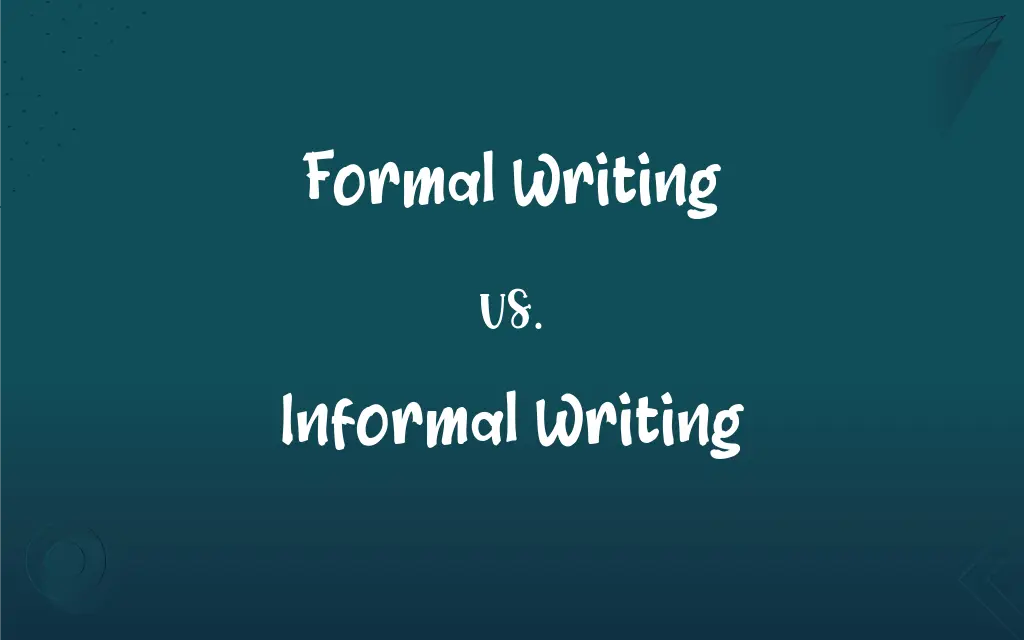Formal Writing vs. Informal Writing: What's the Difference?
Edited by Janet White || By Harlon Moss || Updated on October 13, 2023
Formal writing adheres to traditional conventions and is impersonal, while informal writing has a relaxed, personal style and may include colloquial expressions.

Key Differences
Formal writing is characterized by its adherence to standard grammatical structures and often exhibits a professional or academic tone. The language employed in formal writing is typically more complex and intricate, adhering strictly to grammatical and syntactical rules. In contrast, informal writing tends to be more conversational and may involve the use of slang or colloquial expressions.
In the realm of formal writing, pronouns such as “one” may be used to maintain a sense of impersonality, avoiding the direct reference to self or others. Informal writing might freely use pronouns like “I”, “you”, and “we”, nurturing a direct and personal connection between the writer and reader. Formal writing maintains a distance, employing an objective and neutral tone throughout.
Formal writing often utilizes longer sentences and a sophisticated vocabulary to convey its message with precision and clarity. On the flip side, informal writing may employ shorter sentences and a simpler vocabulary to create an easy, relatable, and digestible narrative. Formal writing tends to avoid contractions (such as can’t, won’t), while informal writing may embrace them for a smoother, conversational flow.
Specific contexts call for formal writing, such as academic essays, official reports, and business correspondence. Whereas, informal writing often finds its place in personal letters, blogs, and social media posts. Thus, formal writing and informal writing are not merely about language choices, but also the appropriateness and effectiveness of communication in various scenarios.
Despite their differences, both formal writing and informal writing serve crucial roles in diverse communicative contexts. Striking a balance and knowing when to employ either style enhances the writer’s ability to convey messages effectively to varied audiences.
ADVERTISEMENT
Comparison Chart
Tone
Professional, impersonal
Relaxed, personal
Vocabulary
Sophisticated, specific
Simple, everyday
Sentence Structure
Complex, detailed
Simple, straightforward
Use of Contractions
Generally avoided
Commonly used
Use of Pronouns
Limited, impersonal (e.g., one)
Frequent, personal (e.g., I, you, we)
ADVERTISEMENT
Use of Slang
Avoided
May be used
Formal Writing and Informal Writing Definitions
Formal Writing
Formal writing avoids the use of contractions and colloquial expressions.
The department shall not sanction any additional expenditures this quarter.
Informal Writing
Informal writing often utilizes simple sentences and everyday vocabulary.
We had a great time at the beach yesterday.
Formal Writing
In formal writing, the tone is consistently professional and impersonal.
The committee concludes that further investigation is warranted.
Informal Writing
Informal writing may incorporate colloquialisms and slang.
That new movie was totally awesome, you have to watch it!
Formal Writing
Formal writing is typically utilized in academic, professional, and official communications.
The board hereby decrees the implementation of the new policy, effective immediately.
Informal Writing
Informal writing allows for personal pronouns and a direct connection with the reader.
I think you’re going to love this new book I found.
Formal Writing
Formal writing often employs a sophisticated and specific vocabulary.
The methodology facilitated a comprehensive analysis of the data.
Informal Writing
In informal writing, contractions are commonly used for a natural flow.
I can’t wait to see you at the party next week.
Formal Writing
Formal writing adheres strictly to grammatical and syntactical rules.
The researcher elucidated the findings in a comprehensive manner.
Informal Writing
Informal writing adopts a relaxed and conversational tone.
Hey, what’s up? I haven’t seen you in ages!
FAQs
What characterizes informal writing?
Informal writing has a relaxed, conversational tone and may include colloquial expressions and personal pronouns.
When is formal writing typically used?
Formal writing is used in academic essays, official reports, and professional communication.
When might one use informal writing?
Informal writing is suitable for personal letters, blogs, social media posts, and friendly communication.
What is formal writing?
Formal writing adheres to strict grammatical rules and maintains a professional, impersonal tone.
Can formal writing use contractions?
Formal writing typically avoids contractions to maintain a formal and polished tone.
What type of vocabulary is used in formal writing?
Formal writing employs a sophisticated and specific vocabulary, avoiding casual language.
How does informal writing approach vocabulary use?
Informal writing uses simple, everyday vocabulary and is less strict about language rules.
Are personal pronouns used in informal writing?
Yes, informal writing frequently uses personal pronouns to connect with the reader.
Does formal writing allow for emotional expression?
Formal writing often restricts emotional expression to maintain neutrality and professionalism.
Is formal writing ever used in personal contexts?
Rarely, as formal writing is generally reserved for more professional and official communications.
What is the primary purpose of formal writing?
Formal writing aims to convey information or arguments clearly and professionally, respecting established conventions.
How does formal writing handle pronouns?
Formal writing often limits the use of personal pronouns to maintain objectivity.
Are contractions acceptable in informal writing?
Yes, contractions are commonly used in informal writing to establish a natural, conversational flow.
Can informal writing include slang?
Yes, informal writing may incorporate slang and colloquial expressions for relatability.
Can informal writing be used in professional contexts?
Informal writing may be used in certain professional contexts, such as internal communications, depending on organizational culture.
Can informal writing express emotions?
Yes, informal writing can express emotions and use expressive language freely.
Is slang permissible in formal writing?
Slang is generally avoided in formal writing to uphold a professional tone.
How are sentences structured in informal writing?
Sentences in informal writing are typically straightforward and may be simpler and shorter.
What is the main goal of informal writing?
Informal writing seeks to establish a personal connection and communicate messages in a relatable, easy-going manner.
How complex are sentences in formal writing?
Sentences in formal writing are often complex, utilizing subordinate clauses and varied structures.
About Author
Written by
Harlon MossHarlon is a seasoned quality moderator and accomplished content writer for Difference Wiki. An alumnus of the prestigious University of California, he earned his degree in Computer Science. Leveraging his academic background, Harlon brings a meticulous and informed perspective to his work, ensuring content accuracy and excellence.
Edited by
Janet WhiteJanet White has been an esteemed writer and blogger for Difference Wiki. Holding a Master's degree in Science and Medical Journalism from the prestigious Boston University, she has consistently demonstrated her expertise and passion for her field. When she's not immersed in her work, Janet relishes her time exercising, delving into a good book, and cherishing moments with friends and family.































































